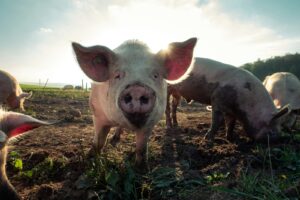While details about the H5H1 outbreak in dairy cattle in the US have been really sparse, a new pre-print provides some important info. (A pre-print is a non-peer reviewed version of a paper that’s put on an open access server. This situation highlights the value…good labs get good data out to let people know and to get feedback. There’s a lot of complete crap on pre-prints that dodgy groups put up to get publicity or advance a cause, with no hope if it ever being published in a reputable journal. So, we have to be careful with pre-prints but with this group and the quality of the data, I’m not worried here).
Anyway, here are some highlights of the pre-print from Iowa State University (Hu et al)
Disease in cattle
They describe what has largely been reported before. Infected cattle had decreased appetite, decreased milk production and abnormally appearing milk. Signs peaks 4-6 days after they started and cows got better on their own within 10-14 days.
That’s pretty ‘flu-like’.
Affected cows were most often older cows in the middle of their lactation periods. Things seem to have started in late February.
Other species
Dead birds and cats were reported on farms and close by. Not long after, H5N1 was isolated from a skunk, and then a dairy worker. The pre-print mentions virus from “humans in Texas during March 2024”, while only 1 human infection has been reported with the cattle outbreak, to my knowledge. It’s not clear whether there are more unreported cases, or whether “humanS” is a typo. Let’s hope it’s a typo and there was just one human infection.
Identification and characterization of H5N1 flu virus
H5N1 flu was identified in milk samples from cattle and lung and brain samples from dead cats. The virus was classified as clade 2.3.4.4b, consistent with a strain that’s been circulating in birds in the area. The genomes of virus from the cattle, wild birds, cats and person were nearly 100% identical and shared a common ancestor, confirming a link.

More detailed study of the virus genome indicated that it was a reassortment of the H5N1 genotype B3.7 and a low pathogenicity avian influenza (LPAI) virus. The B3.7 ancestor emerged in 2023 from an H5N1 virus and a different LPAI strain. This highlights the tendency of flu viruses to evolve and reassort (mix with other flu viruses) and is a major reason we pay attention to flu. This current strain is a bit of a nothing-burger for humans, but we’re worried about what it could become if it keeps spreading, spilling over to other species and evolving or re-assorting.
Surveillance for important genetic mutations
This is still an avian virus. It can spill into mammals but isn’t (yet) well adapted for sustained transmission in mammals. There are some genetic markers that indicate a greater ability to infect mammalian cells and therefore spread in mammals, including people. H5N1 isolates from the cattle and cats had some changes that might increase their ability to infect people, but none contained the mix of other mutations that are also important. So, this strain, while potentially able to spread cow-cow via milk, doesn’t have the range of genetic signatures (yet) that would suggest that it’s going to be a problem for humans.
It’s good to see some details, and good to see that this virus hasn’t yet evolved to something that would be expected to cause widespread problems in mammals. The lack of epidemiological data and information about how this virus has spread between dairy farms is still a big issue. It’s been a textbook example of how NOT to do outbreak communications, which is incredibly frustrating. That’s hampered risk assessment and contingency planning. However, it’s good to see that some scientific papers are coming, so we’ll hopefully get more relevant information in the near future.









